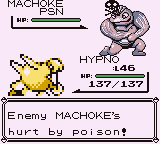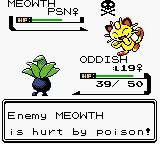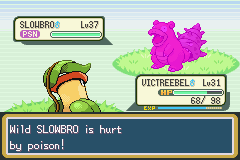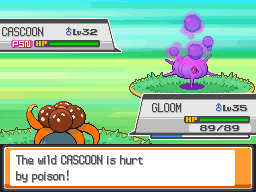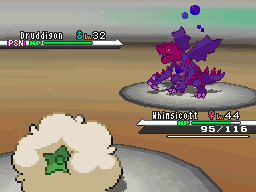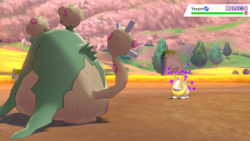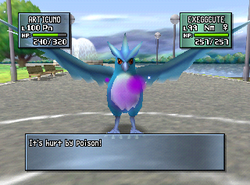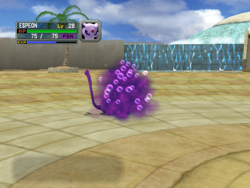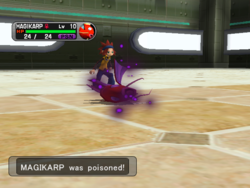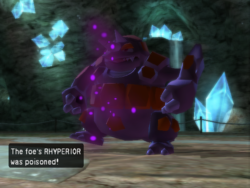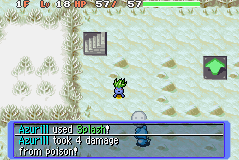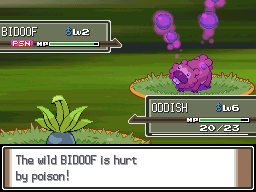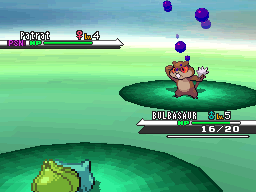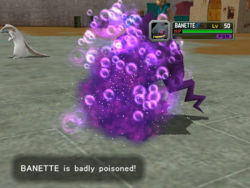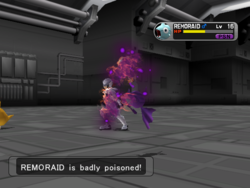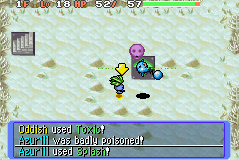Poison (status condition): Difference between revisions
YoungMan16 (talk | contribs) |
YoungMan16 (talk | contribs) |
||
| Line 442: | Line 442: | ||
===''[[Pokémon the Series: Black & White]]''=== | ===''[[Pokémon the Series: Black & White]]''=== | ||
* In ''[[BW022|A Venipede Stampede!]]'', Ash became poisoned when a wild {{p|Venipede}} headbutted him, activating Venipede's {{a|Poison Point}}. He was cured by a remedy that {{an|Cilan}} made. This episode shows that not just Pokémon, but humans can also become poisoned. | * In ''[[BW022|A Venipede Stampede!]]'', Ash became poisoned when a wild {{p|Venipede}} headbutted him, activating Venipede's {{a|Poison Point}} [[Ability]]. He was cured by a remedy that {{an|Cilan}} made. This episode shows that not just Pokémon, but humans can also become poisoned. | ||
* In ''[[BW032|Facing Fear with Eyes Wide Open!]]'', [[Ash's Scraggy]]'s aggressiveness towards a group of {{p|Foongus}} caused the Foongus to use Poison Powder in retaliation, affecting all of Ash, {{an|Iris}}, and Cilan's Pokémon except for {{AP|Oshawott}}, who had been training with his Trainer and {{TP|Iris|Excadrill}} who was not out. While Iris took care of the sick Pokémon, Ash, Oshawott, and Cilan went to a nearby pond to get [[Remeyo weed]] for Iris's poison remedy. After fending off the pond's {{p|Tympole}}, Ash and Cilan caught the Tympole's leader, {{AP|Palpitoad}}, and its ally, {{TP|Cilan|Stunfisk}}, respectively, allowing them access to the herbs. | * In ''[[BW032|Facing Fear with Eyes Wide Open!]]'', [[Ash's Scraggy]]'s aggressiveness towards a group of {{p|Foongus}} caused the Foongus to use Poison Powder in retaliation, affecting all of Ash, {{an|Iris}}, and Cilan's Pokémon except for {{AP|Oshawott}}, who had been training with his Trainer and {{TP|Iris|Excadrill}} who was not out. While Iris took care of the sick Pokémon, Ash, Oshawott, and Cilan went to a nearby pond to get [[Remeyo weed]] for Iris's poison remedy. After fending off the pond's {{p|Tympole}}, Ash and Cilan caught the Tympole's leader, {{AP|Palpitoad}}, and its ally, {{TP|Cilan|Stunfisk}}, respectively, allowing them access to the herbs. | ||
* In ''[[BW054|The Four Seasons of Sawsbuck!]]'', a Pokémon [[photography|photographer]] named {{OBP|Robert|BW054}} became poisoned by an {{p|Amoonguss}}'s Poison Powder attack while trying to save a {{p|Deerling}} from a similar fate. He was cured by the Deerling's {{p|Sawsbuck}} friends with the help of a mysterious lake. | * In ''[[BW054|The Four Seasons of Sawsbuck!]]'', a Pokémon [[photography|photographer]] named {{OBP|Robert|BW054}} became poisoned by an {{p|Amoonguss}}'s Poison Powder attack while trying to save a {{p|Deerling}} from a similar fate. He was cured by the Deerling's {{p|Sawsbuck}} friends with the help of a mysterious lake. | ||
Revision as of 22:40, 15 April 2022

Poison (Japanese: 毒 poison) is a non-volatile status condition that causes a Pokémon to take damage over time. In the games, it is often abbreviated as PSN.
It is often caused by Poison-type moves. Poison- and Steel-type Pokémon are normally immune to being poisoned.
There is also a special kind of poison condition, known as bad poison (Japanese: 猛毒 deadly poison). The amount of poison damage inflicted to a badly poisoned Pokémon increases over time.
In the core series games
Effect
In battle
In battle, a poisoned Pokémon takes damage each turn. Regular poison inflicts a fixed amount of damage each turn, while bad poison inflicts an increasing amount of damage each turn. The exact amount of damage varies between generations.
Generation I
A poisoned Pokémon will take damage equal to 1/16 of its maximum HP every turn, after it attacks, or at the end of the turn if it did not attack. If a poisoned Pokémon causes an opponent to faint, the poisoned Pokémon will not take damage that turn.
A badly poisoned Pokémon takes damage equal to 1/16 of its maximum HP (rounded down, but set to 1 HP if it would be less) on the first turn, after which damage increases by 1/16 each time it takes poison damage. The damage stops increasing when it equals . When a badly poisoned Pokémon is affected by Haze, switches out, or when the battle ends, its poison status becomes regular poison.
If a Pokémon badly poisoned by Toxic is also under the effect of Leech Seed, both types of recurrent damage will draw upon the same N value to calculate how many multiples of 1/16 of the Pokémon's HP is taken as damage, and both will increase that value. If a badly poisoned Pokémon successfully uses Rest, it will be cured of poison, but N is not reset; if it then suffers burn, Leech Seed or poison damage, that damage will draw upon the N value, and the N value will still increase by 1 each time (however, if the Pokémon is poisoned with Toxic, the N value will be reset to 1).
Generation II
A poisoned Pokémon will take damage equal to 1/8 of its maximum HP each turn.
Bad poison damage no longer interacts with other types of recurrent damage. Haze no longer affects poisoning.
While Steel-type Pokémon cannot be poisoned by Poison-type moves, they can be poisoned by Twineedle.
Generation III and IV
Poison damage is now taken at the end of each turn, regardless of whether a Pokémon faints.
A badly poisoned Pokémon will remain badly poisoned even if switched out or the battle ends, although the counter is reset.
Steel-type Pokémon can no longer be poisoned by any moves, including Twineedle.
Generation V onward
At the end of the battle, bad poison now becomes regular poison.
Poisoned Pokémon take double damage from Hex and Venoshock.
Poison- and Steel-type Pokémon can be poisoned by a Pokémon with the Ability Corrosion.
If a Dynamaxed opponent in a Max Raid Battle becomes badly poisoned, it will instantly become normal poison.
Outside of battle
From Generation I to IV, outside of battle, all poisoned Pokémon in the player's party lose one HP every four steps the player takes (every five steps in Pokémon FireRed and LeafGreen).
However, when the player is moving automatically (such as when following the NPC found at the East exit of Pewter City, or when stepping on the traps at the Team Rocket Hideout, or when entering Lance's room at the Indigo Plateau), the poison step count remains unchanged and no HP is lost as a result of poison.
Pokémon with Immunity do not take poison damage outside of battle. (Pokémon with Magic Guard still do, however.)
Generation I to III
Poisoned Pokémon take poison damage until they faint. If the player's last conscious Pokémon faints this way, the player blacks out.
Generation IV
Outside of battle, if a poisoned Pokémon is brought down to one HP due to poison damage, it will be cured of poison instead of fainting.
Generation V onward
Poisoned Pokémon no longer take poison damage outside of battle.
Appearance
In Generation V, a poisoned Pokémon glows purple while in battle; from Generation VI onward, a poisoned Pokémon continuously releases bubbles of poison from its body.
In Generation V, the poison status condition icon for badly poisoned Pokémon has dark purple characters instead of white; in Generation VI, both the icon and text change color.
Regular poison
Core series games

|
This section is incomplete. Please feel free to edit this section to add missing information and complete it. Reason: Generation VI and VII images |
Side series games
Spin-off series games
Bad poison
Core series games
Side series games
Spin-off series games
Causes
Regular poison
Moves
The following moves may poison the target:
|
Other causes
A Pokémon has a 30% chance of being poisoned after making contact with a Pokémon with the Poison Point Ability, and a 9% chance after making contact with a Pokémon with Effect Spore. Poison Touch has a 30% chance (20% in the Japanese versions of Pokémon Black and White) of poisoning the target when the user uses a contact move. A Pokémon can also be poisoned if it directly poisons a Pokémon with the Synchronize Ability.
Bad poison
Moves
The following moves may badly poison the target:
|
Other causes
The item Toxic Orb badly poisons the holder at the end of the turn. From Generation V onward, a Pokémon can also be badly poisoned if it badly poisons a Pokémon with Synchronize (prior to Generation V, Synchronize only inflicts regular poison).
Curing
Poison (including bad poison) can be cured with the use of an Antidote, Drash Berry (Generation III only) and Pecha Berry (PSNCureBerry in Generation II). In addition, like all other major status conditions, it can be cured by the items Full Heal, Rage Candy Bar, Lava Cookie, Old Gateau, Casteliacone, Lumiose Galette, Shalour Sable, Big Malasada, Full Restore, Heal Powder, Lum Berry (MiracleBerry in Generation II), and Sacred Ash.
The moves Refresh and Rest remove the poison status condition from the user, while Heal Bell (unless the Pokémon has Soundproof as their Ability in Generation III and IV) and Aromatherapy remove it from all Pokémon in the user's party. In addition, the move Psycho Shift shifts the poison onto its target (thereby healing the user). In Generation I only, using Haze cures the opponent from poison.
Pokémon with Natural Cure will be cured upon switching out, those with the Hydration Ability will be cured whilst it is raining. Pokémon with Shed Skin have a 1/3 chance of being cured every turn, and Pokémon with Healer have a 30% chance of curing their allies.
Prevention
In general, Steel- and Poison-type Pokémon cannot be poisoned. However, they can be poisoned by Pokémon with the Corrosion Ability. Additionally, in Generation II, the move Twineedle can poison Steel-type Pokémon. If a Pokémon is poisoned while not Poison- or Steel-type (such as while affected by a type-changing move or before evolving into a Poison-type or Steel-type Pokémon), it will remain poisoned.
Pokémon with the Ability Immunity cannot be poisoned. Pokémon with the Comatose Ability and Minior in Meteor Form are completely immune to being poisoned. Pokémon with the Ability Pastel Veil will prevent itself and its allies from being poisoned. Pokémon with the Ability Leaf Guard will be protected from status conditions in harsh sunlight. The Ability Magic Guard will prevent damage due to poison from being taken in battle; however, it does not prevent the damage from being taken outside of battle.
The moves Safeguard and Misty Terrain (for grounded Pokémon) will protect the party from status conditions for five turns. A Pokémon behind a substitute cannot be poisoned, except due to Synchronize or a held Toxic Orb.
Advantages
While poisoning and badly poisoning, like all major status conditions, have primarily negative effects, it can be advantageous to be poisoned in certain conditions. Pokémon with Guts, Marvel Scale, and Quick Feet will have their Attack, Defense, and Speed increased by 50%, respectively, if poisoned or afflicted by any other non-volatile status condition excluding sleep and freeze; however, in Generation IV, sleep will increase the Attack of Pokémon with Guts. Poisoning will increase the attack of a Pokémon with Toxic Boost by 50%, and the base power of Facade is doubled (from 70 to 140) when inflicted with poison. A Pokémon with Poison Heal will regain 1/8th of its maximum HP at the end of each turn instead of taking damage. When capturing Pokémon, the poison status also adds a 1.5× multiplier to the catch rate of any given Pokémon.
In competitive battling in Generation I, as Pokémon were not healed before link battles in the handheld games, players would often enter battles with their Pokémon already poisoned, as it prevented them from being affected by other more harmful status conditions; also, poison only inflicted 1/16 of the Pokémon's total HP as damage each turn rather than 1/8 as it does from Generation II onward. This tactic was not viable in the Pokémon Stadium series, as Pokémon were restored to full health before battle in these games.
Other in-game effects
If a poisoned Pokémon gains the Ability Immunity through the use of Skill Swap, Trace or another method, the poison or bad poison status will be removed.
In Pokémon Emerald, when the player is inside the Battle Pyramid, the types of Pokémon encountered on each floor follow a set of categories, on the second floor the player will encounter Pokémon that poison as their main tactic.
In the Generation IV games, Pokémon Platinum, HeartGold and SoulSilver, at the Battle Arcade, one of the effects caused by the roulette is causing the poison status; Pokémon that would normally be immune to poison are unaffected. The poison will last for a single battle.
If a Pokémon has Merciless and hits a poisoned target, it will score a critical hit.
In the spin-off games
Pokémon Mystery Dungeon
Like the main games, Pokémon Mystery Dungeon also features both normal poisoning as well as bad poisoning. When a Pokémon is poisoned, it takes damage every ten turns and is also prevented from regenerating HP. Poison does not disappear over turns. When a Pokémon is badly poisoned, it takes damage every two turns and also prevents regenerating HP. Similar to the main games, the poison conditions do not disappear over turns but can be healed with certain moves or items, and by going to the next floor.
Rumble series
Poison and bad poison (Poisoned and Badly Poisoned when inflicted in-game) are negative statuses in the Rumble series. When a Pokémon is Poisoned, its HP will gradually drain at a rate determined by the Power of the Pokémon that inflicted it for ten seconds. However, if the affected Pokémon is controlled by a player, moving around will make the condition wear off faster, with the minimum duration depending roughly on the Pokémon's Speed. While Poisoned, purple bubbles emanate from around the affected Pokémon's head. The effects under Badly Poisoned are similar, but the rate at which HP is depleted gradually increases while the status lasts and purple smoke emanates from the Pokémon's head instead of bubbles. Though most negative statuses will replace one another if one is inflicted while another is present, Poisoned cannot replace Badly Poisoned (though Badly Poisoned will replace Poisoned).
No types are immune to poison or bad poison, but Pokémon with the Poison Boost or Steady Special Traits cannot be poisoned or badly poisoned, and those with the Reflector Trait will cause the user of the poison-inflicting move to become poisoned or badly poisoned instead if hit by one.
Pokémon Conquest
Like the main series, a Pokémon inflicted with poison is protected from other status conditions and does not wear off over time. Normal poison can be inflicted by attacks, abilities, or by a Pokémon ending their turn in a poison bog. Bad poison can only be inflicted by the effect of Poison Fang. As in the main series, Poison- and Steel-types are immune to poison. Poison can be cured through certain Warrior Skills, items, or by ending a Pokémon's turn in a hot spring or a water bucket.
Pokémon afflicted with normal poison lose 1/8th their max HP, rounded down, at the end of their side's turn, even if the poisoned Pokémon itself took no action. Pokémon afflicted with bad poisoning lose 1/16th of their max HP initially, with damage increasing by 1/16 at the end of their side's turn. Enemy Warriors defeated through poison damage are not treated as being defeated by the player, and thus cannot be recruited after the battle.
Pokémon Shuffle
In Pokémon Shuffle, a poisoned Pokémon takes 50% more damage from Poison-type Pokémon.
Poison can be inflicted by Pokémon with the Poison Skill.
Poison, Ground, Rock, Ghost, and Steel-type Pokémon are immune to poison.
In the anime

The poison status has been shown multiple times in the anime:
Original series
- In Princess vs. Princess, Jessie's Arbok proceeded to poison Yumi's Primeape by biting its fist.
Pokémon the Series: Ruby and Sapphire
- In Sharpedo Attack!, while Brock was battling a Sharpedo, it suddenly fainted. He examined it and realized that it had been poisoned by Seviper's Poison Tail. Brock did everything he could for Sharpedo, but even though he didn't have any medicine, Sharpedo's poison got cured by itself after a while.
Pokémon the Series: Diamond and Pearl
- In Evolving Strategies!, during Ash's battle against Paul at Lake Acuity, Ash's Buizel was poisoned by a cloud of Smog from Paul's Magmortar.
- In Keeping In Top Forme!, Shaymin, Piplup, and Pikachu all got poisoned, Shaymin from getting exposed to some kind of poison and Pikachu and Piplup from a wild Shroomish using Poison Powder on them. Shaymin was cured by Brock, who used a Pecha Berry on it, and Pikachu and Piplup were cured by Shaymin's Aromatherapy.
- In A Real Rival Rouser!, during the Lily of the Valley Conference battle between Paul and Ash, Paul's Drapion used Toxic Spikes, which poisoned every Pokémon Ash sent out (regardless of type). Ash's Buizel, Staraptor, Torterra, Infernape, and Gliscor all got poisoned from the Toxic Spikes. Eventually, Infernape managed to get rid of the Toxic Spikes by using Flare Blitz while being underground.
- In The Brockster Is In!, Ash's Pikachu and all of Normajean's Pokémon got poisoned by Poison Stings and Poison Jabs from a group of wild Tentacruel. Brock used Pecha Berries to cure them. He also had his Chansey use Soft-Boiled on Normajean's Pichu. In this episode, it seems that a fever and difficulty breathing is a side effect of the poison.
Pokémon the Series: Black & White
- In A Venipede Stampede!, Ash became poisoned when a wild Venipede headbutted him, activating Venipede's Poison Point Ability. He was cured by a remedy that Cilan made. This episode shows that not just Pokémon, but humans can also become poisoned.
- In Facing Fear with Eyes Wide Open!, Ash's Scraggy's aggressiveness towards a group of Foongus caused the Foongus to use Poison Powder in retaliation, affecting all of Ash, Iris, and Cilan's Pokémon except for Oshawott, who had been training with his Trainer and Excadrill who was not out. While Iris took care of the sick Pokémon, Ash, Oshawott, and Cilan went to a nearby pond to get Remeyo weed for Iris's poison remedy. After fending off the pond's Tympole, Ash and Cilan caught the Tympole's leader, Palpitoad, and its ally, Stunfisk, respectively, allowing them access to the herbs.
- In The Four Seasons of Sawsbuck!, a Pokémon photographer named Robert became poisoned by an Amoonguss's Poison Powder attack while trying to save a Deerling from a similar fate. He was cured by the Deerling's Sawsbuck friends with the help of a mysterious lake.
- In Rocking the Virbank Gym! Part 1 and Part 2, Ash's Unfezant, Leavanny, Pignite, Palpitoad, and Pikachu were all poisoned during Ash's Virbank Gym battle against Roxie's Poison-type Pokémon. Out of these, Leavanny and Pignite were badly poisoned. Roxie also cured Pignite and Pikachu of their poisoning with Pecha Berries.
- In Strong Strategy Steals the Show!, Stephan's Zebstrika was poisoned by a Sludge Wave from Ash's Palpitoad. However, Stephan countered this by having Zebstrika use Facade, which was powered up due to the poison.
Pokémon the Series: XY
- In Mega Evolution Special I, Mairin had Chespin, Chespie, use Toxic to badly poison a wild Flabébé, allowing her to catch the Single Bloom Pokémon.
- In An Undersea Place to Call Home!, Ash's Pikachu was badly poisoned by a wild Skrelp's Toxic attack. He was cured with an Antidote by Eddy and Lindsey.
- In A Stealthy Challenge!, Sanpei's Greninja was poisoned by a Poison Jab from Saizo's Barbaracle. It was later cured when Clemont gave it a Pecha Berry.
- In The Green, Green Grass Types of Home!, Ash's Fletchinder and Hawlucha were both poisoned by a cloud of Poison Powder from Ramos's Weepinbell during Ash's Coumarine Gym battle. The poison quickly ate at their stamina, causing them both to fall to the Flycatcher Pokémon. Frogadier managed to avoid the same fate by using its Frubbles as a mask, preventing it from inhaling the spores.
- In Mega Evolution Special IV, Alain's Charizard was poisoned by a Venoshock attack from a Trainer's Mega Venusaur *. After the battle, Alain cured Charizard with a Pecha Berry.
- In A Windswept Encounter!, Ash's Noibat was poisoned by a wild Breloom's Poison Powder. He was cured by a wild Floette using Aromatherapy on him.
Pokémon the Series: Sun & Moon
- In The Sun, the Scare, the Secret Lair!, Ash's Rowlet was poisoned by a Sludge Bomb from James's Mareanie. It was cured with an Antidote given to Ash by Professor Kukui. This episode also started the running gag of Mareanie poisoning James while showing its affection to him, causing his face to look like a Mareanie.
- In Love at First Twirl!, Ash's Rowlet was badly poisoned by Poipole when Rowlet tried to attack it and it panicked, using Toxic on Rowlet. Rowlet was later cured of its poisoning by Lillie.
- In The Dealer of Destruction!, Ash's Pikachu was poisoned by a Poison Jab from Guzma's Golisopod. Later, Kiawe gave Ash a Pecha Berry to heal Pikachu's poison.
- In Drawn with the Wind!, Sandy was poisoned by a Sludge Bomb from James's Mareanie. It was healed from its poison soon after by Shaymin's Aromatherapy.
- In The One That Didn't Get Away!, a Kyogre was poisoned by a hunter and his minions. It was healed from its poison when Lana gave it food laced with Antidote that was attached to her fishing lure.
- In The Road to The Semifinals!, during Lana's battle against Guzma in the second round of the Manalo Conference, Lana's Primarina was poisoned by a Poison Jab from Guzma's Golisopod, eroding its stamina throughout the battle and eventually leading to its defeat. After the battle, Primarina was healed from its poison by Shaymin's Aromatherapy.
- In The Wisdom Not to Run!, Ash's Torracat was poisoned by a Poison Jab from Guzma's Golisopod, contributing to its defeat soon after.
Pokémon Journeys: The Series
- In Working My Way Back to Mew!, Goh's Scorbunny was poisoned by a cloud of Poison Powder from a Venonat that Goh was catching, requiring it to be taken to a Pokémon Center to be healed.
- In A Little Rocket R & R!, Ash's Pikachu was poisoned by a Sludge Bomb from a Team Rocket Grunt's Toxicroak, weakening him enough to be captured by Matori's handpicked unit. Ash later rescued his partner and healed the poison by feeding him a Pecha Berry.
- In Making Battles in the Sand!, Ash's Riolu was poisoned by a Poison Sting from a Trainer's Tentacruel, leading to it fainting immediately afterward due to the damage it had already sustained.
- In Healing the Healer!, a Suicune was poisoned by a Sludge Bomb bombardment from a Pokémon hunter group's Pokémon. Goh later cured Suicune's poison by giving it some Pecha Berries. Later in the episode, Goh's Cinderace was also poisoned by a Sludge Bomb from the hunter group's Garbodor.
- In All Out, All of the Time!, Goh had his Pyukumuku badly poison a wild Bruxish with Toxic during the Pokémon Catch Adventure Race, allowing him to catch it.
In the manga

Pokémon Adventures
Red, Green & Blue arc
In The Secret of Kangaskhan, Red cured a poisoned baby Kangaskhan with an Antidote.
In A Tale of Ninetales, Red's Pikachu named Pika, while under Blue's ownership, used Toxic to badly poison a wild Ninetales that Blue was trying to catch.
In A Hollow Victreebel, Red used his Victreebel's Poison Powder to poison a Nidoking in order to make him easier to catch. This is in spite of the fact that Nidoking, as a Poison Pokémon, should be immune to the move.
In A Charizard...and a Champion, during the Indigo League Tournament finals, Blue's Charizard was poisoned after Red had his Venusaur, Saur, use Poison Powder on him. This forced Blue to recall Charizard and send Machamp out in his place. Later on in the round, Blue's Machamp was badly poisoned by a Toxic attack from Red's Snorlax, Snor, forcing Blue to recall him and send Ninetales out in his place.
FireRed & LeafGreen arc
In Put Your Beast Foot Forward, Blue and his Charizard and Golduck were badly poisoned by a Toxic attack from a swarm of wild Shuckle commanded by Orm's Shuckle.
Emerald arc
In Swanky Showdown with Swalot, Spenser's Crobat badly poisoned an Electrode with Poison Fang during a demonstration battle at the Battle Frontier opening ceremony.
In Just My Luck...Shuckle, Lucy's Seviper badly poisoned Emerald's borrowed Blissey with Poison Fang. However, she was later cured from it thanks to her Natural Cure. During the same round, Emerald's borrowed Starmie and Rapidash were also badly poisoned, the former by a Toxic attack from Lucy's Shuckle and the latter by Seviper's Poison Fang.
In You Need to Chill Out, Regice, Emerald's borrowed Hitmonchan was badly poisoned by a Toxic attack from Brandon's Registeel, causing it to faint when Emerald was unable to find a proper healing item from his Battle Bag.
Platinum arc
In Uprooting Seedot, Platinum's rental Qwilfish poisoned and subsequently defeated a Seedot with Toxic Spikes during Platinum's Battle Factory challenge.
In Outlasting Ledian, Thorton's rental Ledian was poisoned by Platinum's rental Qwilfish activating its Poison Point Ability, resulting it fainting from the poison damage soon after.
Black & White arc
In Big City Battles, Black's Braviary, Brav, was poisoned by Burgh's Whirlipede activating its Poison Point Ability, causing it to faint soon after.
In Into the Quarterfinals!, Black's Galvantula, Tula, was poisoned by Looker's Croagunk during the Pokémon League quarterfinals, almost costing him the match.
Sun, Moon, Ultra Sun & Ultra Moon arc
In The Party Crasher and Guzma the Destroyer, Gladion's Porygon was poisoned by a Poison Gas attack from Moon's Alolan Grimer. After the battle, Gladion used a Pecha Berry to heal it.
In Battle in Vast Poni Canyon, Faba's Hypno was poisoned by Plumeria's Salazzle.
Sword & Shield arc
In Toasty!! Battle Against Toxapex, Henry's Thwackey, Twiggy, was poisoned when Nessa's Toxapex protected itself with Baneful Bunker.
Pokémon Gotta Catch 'Em All
In GDZ68, Shu's Pikachu was poisoned by a Toxic attack from a Trainer's Kingdra. Shu was able to cure him with an Antidote.
In the TCG

- Main article: Special Conditions (TCG) → Poisoned
In the Trading Card Game, Poisoned is one of the five Special Conditions along with Asleep, Burned, Confused, and Paralyzed. When a Pokémon is Poisoned, a poison counter is placed on it and one damage counter is put on the Pokémon in between each turn. Some attacks require the player to put two, three, or even four damage counters on a Pokémon between turns, instead of the normal one. The condition can be removed by returning the affected Pokémon to the Bench or by evolving it. Unlike the Pokémon games, a Pokémon can be afflicted with Poison and Burned at the same time, along with one of Asleep, Confused, and Paralyzed.
Trivia
- Poison is the only status condition to have an effect outside of battle; however, from Generation V onward, it no longer has an effect outside of battle either.
In other languages
|
Poisoned
|
Badly poisoned
| ||||||||||||||||||||||||||||||||||||||||||||||||||||||||||||||||||||||||||||||||||||||||||||
| Status conditions | |||
|---|---|---|---|
| BURN | FREEZE | PARALYSIS | POISON |
| SLEEP | CONFUSION | FLINCH | FAINTING |

|
This game mechanic article is part of Project Games, a Bulbapedia project that aims to write comprehensive articles on the Pokémon games. |


